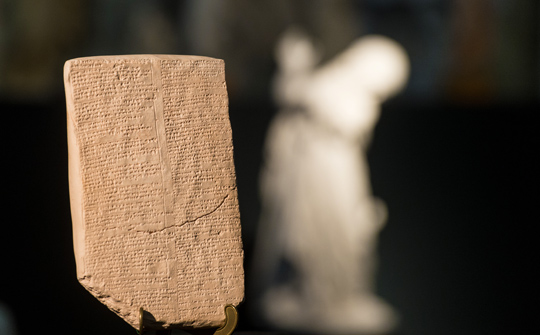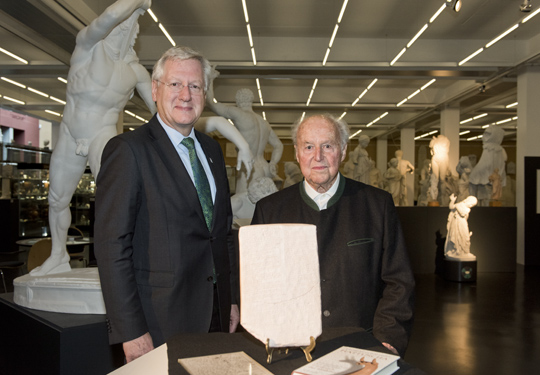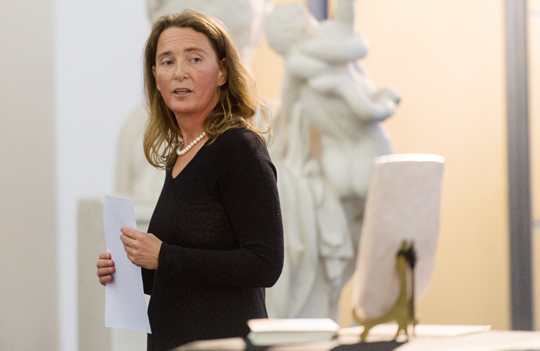Magical Purification
Freiburg, Feb 15, 2018
Objects from days gone by often find their way into the University of Freiburg’s Archaeological Collection as gifts. Frequently, the donated pieces are valuable. The most weird and wonderful new acquisitions are now being presented in a series. The first installment features something truly unique – a plaster cast of a one-of-a-kind Bronze Age cuneiform tablet.

The tablet provided temple priests with directions for ritual purification of those who had eaten unclean or cursed food. Photo: Patrick Seeger
Viewed from today’s perspective, the copy of the tablet looks like an open book with the facing pages covered in closely-spaced type. The author used a sharp object to carve the grooves into unfired clay. The two lower corners of the tablet have broken off. The cast, which was made with great care, shows the line of the break as well. In the original, it’s slightly arched and extends from the left to the right edge. The cuneiform tablet tells of a ritual. It is supposed to help people who have, for example, consumed unclean or cursed bread or oil. Regine Pruzsinszky, Professor of Ancient Eastern Philology at the Institute of Archaeological Sciences (IAW) has studied the tablet and its inscriptions in depth. “The beginning of this religious and culturally significant ritual tablet is often interpreted as a purity law. To this day, it is described in various standard works on food legislation as the oldest food law,” Pruzsinszky explains.

During a ceremony, Fritz Ruf (right) presents the donation to Rector Hans-Jochen Schiewer. Photo: Patrick Seeger
The tablet was found in Hattuša, the capital of the Hittites, in what is now Central Anatolia. The directions were written by a man named Ammihatna, who served as a priest in the temple of the goddess Išḫara. Written in the Hittite language, his comments were an appeal to others at the temple. The tablet is a special find that is now at home at the University of Freiburg. Dr. Jens-Arne Dickmann, the Curator of the university’s Archaeological Collection, says, “The piece broadens the collection’s horizon.”
Only cast of its kind in the world
The original ritual tablet is located in the Archaeological Museum in Istanbul, Turkey. It is a gift from Dr. Fritz Ruf, a retired nutritionist and food chemist. “It’s the only existing replica of the tablet. It’s the most valuable and wonderful piece in my archaeological collection,” says the 90-year-old resident of Heilbronn. “I was very proud when I received it for my 65th birthday in 1992. Now, it is important to me that it ends up in the right hands. As one of the oldest alumni of the University of Freiburg, the first thing I thought of was the Archaeological Collection,” he says.

Regine Pruzsinszky will use the tablet in order to teach her students the principles of cuneiform writing. Photo: Patrick Seeger
In 1968, the Hamburg-based company Maizena presented it to Edmund Forschbach on his 65th birthday. The gift was in recognition of Forschbach’s services as a ministerial director in the German Ministry of Health at the time. After Edmund Forschbach died, his family gave the tablet to his friend, Fritz Ruf as a birthday gift. Now students will be able to use the tablet to study the principles of cuneiform writing.
Hans-Dieter Fronz

